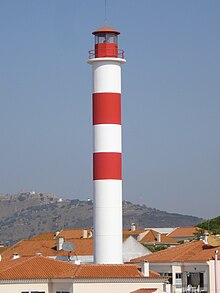Farol da Azeda Índice Curiosidades | Informações | Referências Ligações externas | Menu de navegaçãoPOR065editareditar código-fonte«Lighthouses of Southern Portugal»Marinha Portuguesa (Direcção de Faróis)Fotografiaeexpandindo-oe
Faróis de PortugalSetúbal
portuguêsSetúbalNE
Farol da Azeda

Farol da Azeda
| Coordenadas | 38° 32′ 19″ N, 8° 52′ 42″ O |
|---|---|
| Banhado por | Oceano Atlântico |
| Endereço | |
| Localização | Setúbal, |
| Altitude | 61 m |
| Período de construção | (moderno) |
|---|
| Altura | 31 |
|---|---|
| Altura focal | 61 m |
| Alcance luz | 22 milhas náuticas |
|---|---|
| Luz característica | Luz: Iso Y 6s |
| № internacional | D2151.1 |
|---|---|
| № da ARLHS | POR065 |
| № da NGA | 3568 |
O Farol da Azeda é um farol português que fica localizado no cimo de uma colina, na cidade de Setúbal.
Possui uma torre cilíndrica branca com duas faixas horizontais vermelhas no do topo. Tem lanterna e varandim vermelhos.
É o farol posterior do enfiamento da barra de Setúbal, ficando a 2.815 m a NE (039º 42') do enfiamento anterior, o Farolim da Doca Pesca.
Índice
1 Curiosidades
2 Informações
3 Referências
4 Ligações externas
Curiosidades |
A torre funciona também como reservatório de água para abastecimento à cidade.
Informações |
- Uso actual: Ajuda activa à navegação
- Acesso: R. Central da Azeda / R. Nova de Sintra
- Aberto ao público: local aberto, torre fechada
- Outras designações: Enfiamento posterior da Barra de Setúbal
- Número nacional: 385
- Número internacional: D-2151.1
- Número NGA: 3568
- Número ARLHS: POR-065.[1]
Referências
↑ (em inglês)«Lighthouses of Southern Portugal». The Lighthouse Directory. University of North Carolina at Chapel Hill. 19 de Março de 2009. Consultado em 29 de Abril de 2009
Ligações externas |
- Marinha Portuguesa (Direcção de Faróis)
- Fotografia